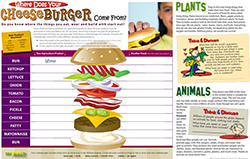Agricultural Literacy Curriculum Matrix
Companion Resource

Where Does Your Cheeseburger Come From?
Do you know the source of the burger, bun and toppings that make a delicious cheeseburger? This student poster breaks down the cheeseburger ingredients to help students correlate the farm-to-fork path. These are available to educators free of charge from Minnesota Agriculture in the Classroom.
URL
Procedures
- Ask, “Do you know where the things you eat, wear and build with start out?” Have students brainstorm places where their food or clothing comes from.
- Wool comes from sheep
- Leather comes from cows
- Cotton comes from cotton plants
- Sugar comes from sugar beets or sugar cane
- Read the paragraph on the top of the poster: “Farms, fields and forests produce our agricultural products. Most of these products must be processed in some way before we can use them. Processing changes raw agricultural products into thousands of things we use every day. Think about a cheeseburger, for example. The parts of a cheeseburger come from many different raw agricultural products.”
- Distribute a poster to each student in classroom
- Instruct, “From the words in the word bank (located on the top left of the page under the heading “Raw Product Word Bank”) choose the name of the agricultural product that is the source of each part of the cheeseburger. Write it in the column on the left.
- Bun – Wheat
- Lettuce - Lettuce
- Onion - Onions
- Tomato - Tomatoes
- Pickle – Cucumber
- Ketchup - Tomato
- Cheese – Milk
- Patty - Beef
- Bun – Wheat
- Ask students if they know of any other foods that we eat and what they are made out of.
- Mac n' Cheese – wheat, milk
- Donuts – wheat and sugar
- Pizza – wheat, tomatoes, meat
- Pepperoni – pork/pigs
- After students have had a chance to brainstorm some other types of foods, have them fill out the right column by instructing “list another food that is made from the same raw product”
- Wheat – pasta
- Lettuce – salad
- Onions – onion rings
- Tomato – pasta sauce
- Cucumbers – salad dressing
- Tomato – salsa
- Milk – ice cream
- Beef – steak
- Wheat – donuts
- After students finish filling out the right column on their poster, direct their attention to the first “Think and Discuss” section on the poster.
- Read the question, “What have you eaten or used today that came from rice, wheat, corn or soybeans?” Have student brainstorm things that they have interacted with.
- Some example items:
- Crayons
- Gasoline (ethanol) – corn
- Some example items:
- Direct the students to the second “Think and Discuss” section and ask the question, “What have you eaten or used today that came from animals?”
- For example: Lipstick – pigs
- To conclude the poster activity with students, remind them to be cognizant throughout the day on other ways their lives are impacted by plant and animal agriculture.
Additional Ag Facts
- Beef Cattle
- The average American consumes 55 pounds of beef each year.
- As a country, we devour nearly 50 billion hamburgers annually.
- Beef cattle are raised in every state in the United States, but mostly in Texas, Oklahoma and Missouri.
- Cattle are ruminant animals which means they have a four-compartment stomach that allows them to eat grass and break down cellulose that humans cannot do.
- Cattle land covers approximately 26% of the land in the United States.
- Wheat
- Wheat is grown in 42 states in the United States.
- Kansas produces enough wheat each year to bake 36 billion loaves of bread and enough to feed everyone in the world for about two weeks.
- An acre of Kansas wheat produces enough bread to feed nearly 9,000 people for a day.
- One bushel of wheat yields approximately 42 pounds of white flour or 60 pounds of whole-wheat flour.
- The average America eats about 20 pounds of pasta each year.
- Tomato
- A tomato truck can hold 50,000 pounds of tomatoes which is about 300,000 tomatoes.
- United States produces the 2nd most tomatoes in the world – China is the first.
- 5% of tomato’s weight is in water.
- American obtain more vitamins from tomatoes than from any other vegetable.
- The average American eats around 24 pounds of tomato each year.
- 93% of American households that have a garden grow tomatoes. It is the most popular vegetable in the United States.
- Three fourths (3/4) of the tomatoes in the Unites States are consumed processed – meaning they are in some other form than raw like salsa, pasta sauce, etc.
- Pig
- The pigs was one of the first animals to be domesticated over 6,000 years ago.
- Pigs exist on every continent except for Antarctica.
- In Denmark there are twice as many pigs as people.
- A pig can run a mile in 7 minutes.
- Pigs can drink up to 14 gallons of water every day.
- Pigs can squeal up to 115 decibels which is louder than a Concorde Jet.
- Dairy Cattle
- A cow that is being milked eats about 100 pounds of feed each day.
- A cow that is being milked drinks about 30-50 gallons of water each day.
- There are six main breeds of dairy cows – but the most common is the Holstein.
- The average Holstein dairy cow weighs about 1,500 pounds.
- An average dairy cow produces about 7-9 gallons of milk a day.
Author
Minnesota Agriculture in the Classroom
